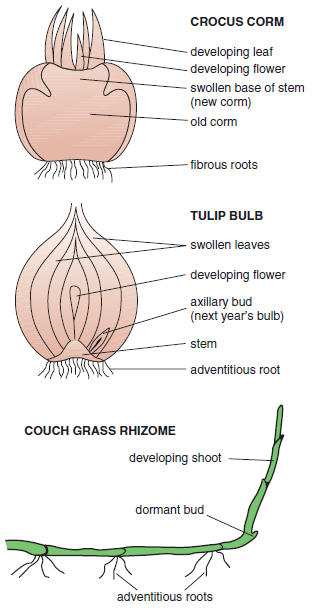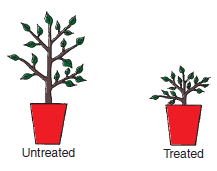Vegetative propagation
Content
Although the life cycle of most plants leads to sexual reproduction, all plants have the potential to reproduce asexually or by vegetative propagation, when pieces of the parent plant are removed and develop into a wholly independent plant. All living cells contain a nucleus with a complete set of genetical information (see genetic code, Pollination and fertilization), with the potential to become any specialized cell type. Only part of the total information is brought into operation at any one time and position in the plant. If parts of the plant are removed, then cells lose their orientation in the whole plant and are able to produce organs in positions not found in the usual organization. These are described as adventitious and can, for example, be roots on a stem cutting, buds on a piece of root, or roots and buds on a piece of leaf used for vegetative propagation. Many plant species use the ability for vegetative propagation in their normal pattern of development, in order to increase the number of individuals of the species in the population. The production of these vegetative propagules, as with the production of seed, is often the means by which the plant survives adverse conditions (see overwintering), acting as a food store which will provide for the renewed growth when it begins. The stored energy in the swollen tap roots of dock and dandelion enable these plants to compete more effectively with seedlings of other weed and crop species, which would also apply to roots of Gypsophila paniculata, carrots and beetroot.
Other natural means of propagation include lateral stems, which grow horizontally on the soil surface to produce nodal, adventitious roots and subsequently plantlets, e.g. runners or stolons of strawberries and yarrow. The adventitious nature of stems is exploited when they are deliberately bent to touch the ground, or enclosed in compost, in the method known as layering, used in carnations, some apple rootstocks, many deciduous shrubs such as Forsythia, and pot plants such as Ficus and Dieffenbachia. The roots of species, especially in the Rosaceae family, are able to produce underground adventitious buds that grow into aerial stems or suckers, e.g. pears, raspberries. By all these methods of runners, layering and suckers, the newly developing plant (propagule) will subsequently become detached from the parent plant by the disintegration of the connecting stem or root. Growth retardation Stem extension growth is controlled by auxins produced by the plant and also by gibberellins that can dramatically increase stem length, especially when externally applied. Growth retardation may be desirable, especially in the production of compact pot plants from species that would normally have long stems, e.g. chrysanthemums, tulips and Azaleas. Therefore, artificial chemicals, such as daminozide (Figure 11.7 ), which inhibit the action of the growth promoting hormones can retard the development of the main stem and also stimulate the growth of side shoots to produce a bushier, more compact plant. Flower production may be inhibited but this can be countered by the application of flower stimulating chemicals.
Pruning Parts of plants can be pruned (removed) to reduce the competition within the plant for the available resources. In this way, the plant is encouraged to grow, flower or fruit in a way the horticulturist requires. A reduction in the number of flower buds of, for example, chrysanthemum, will cause the remaining buds to develop into larger flowers; a reduction in fruiting buds of apple trees will produce bigger apples, and the reduction in branches of soft fruit and ornamental shrubs will allow the plants to grow stronger when planted densely. Pruning will also affect the shape of the plant, as meristems previously inhibited by apical dominance will begin to develop. The success of such pruning depends very much on the skill of the operator, as a good knowledge of the species habit is required. A few general principles apply to most pruning situations:
|
||||||||||||||||||||||||||||






